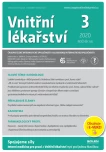Adherence to cardiovascular prevention principles in subjects at high risk
Authors:
Otto Mayer Jr. 1,2; Jan Bruthans 1,3; Julius Gelžinský 1; Markéta Mateřánková 1; Štěpán Mareš 1; Veronika Svobodová 1; Jitka Seidlerová 1,2; Renata Cífková 3; Jan Filipovský 1,2
Authors‘ workplace:
II. interní klinika LF UK a FN Plzeň
1; Biomedicínské centrum LF UK a FN Plzeň
2; Centrum kardiovaskulární prevence 1. LF UK a Thomayerovy nemocnice Praha
3
Published in:
Vnitř Lék 2020; 66(3): 53-60
Category:
Original Contributions
Overview
Background: Asymptomatic high-risk individuals represent one of the highest priorities of cardiovascular prevention, in clinical practice frequently overlooked. We analyzed the real adherence to recommended principles of cardiovascular prevention in primary care subjects.
Methods: Our analysis is based on random general population sample, examined in the frame of post-MONICA survey in 2016/17. Each subject was categorized with regard to its individual cardiovascular risk (based on Sixth Joint European Guidelines) and the real adherence to recommended targets was ascertained.
Results: In total 898 subjects aged 25–75 years (47% males) were analyzed. Of them, 16.7% were classified into “very high risk“ and 36.8% into “high risk“ subgroup; remaining 46.5% were only at moderate or low risk. Regarding adherence to recommended principles, in “very high risk“ category only 58.7% abstain from any form of tobacco, 38% reported appropriate physical activity (≥150 minutes of at least moderate activity weekly), 16.7% had recommended body constitution (BMI 20–25 kg/m2 ), 39.3% appropriate blood pressure (<140/90mm Hg) and only 8.7% reached LDL target (<1.8mmol/l). In “high risk” category was the adherence to these targets as follows: 83.9% (tobacco abstinence), 32.7% (physical activity), 17% (body constitution), 58.2% (blood pressure) and 30.8 % (LDL < 2.5 mmol/l). More acceptable was in both risk categories the therapeutic control of glucose metabolism (HbA1c < 53 mmol/mol in diabetics), i.e. 75% and 81%, respectively.
Conclusions: Global adherence of high-risk subjects to recommended principles of cardiovascular prevention is in primary care far from being optimal, notably in “very high risk“ category.
Keywords:
guidelines – general population – Primary care – risk factors – SCORE – treatment target
Sources
1. Pyorala K, De Backer G, Graham I, et al. Prevention of coronary heart disease in clinical practice. Recommendations of the Task Force of the European Society of Cardiology, European Atherosclerosis Society and European Society of Hypertension. Eur Heart J 1994; 15: 1300–1331.
2. Piepoli MF, Hoes AW, Agewall S, et al. 2016 European Guidelines on cardiovascular disease prevention in clinical practice: The Sixth Joint Task Force of the European Society of Cardiology and Other Societies on Cardiovascular Disease Prevention in Clinical Practice (constituted by representatives of 10 societies and by invited experts): Developed with the special contribution of the European Association for Cardiovascular Prevention & Rehabilitation (EACPR). Eur J Prev Cardiol 2016; 23: np1–np96.
3. Kotseva K, De Backer G, De Bacquer D, et al. Lifestyle and impact on cardiovascular risk factor control in coronary patients across 27 countries: Results from the European Society of Cardiology ESC-EORP EUROASPIRE V registry. Eur J Prev Cardiol 2019: 2047487318825350.
4. Mayer O, Bruthans J, Rychecká M Změny úrovně sekundární prevence ischemické choroby srdeční mezi lety 1995 a 2017. Vnitř Lék 2018; 64: 1190–1199.
5. Perk J, De Backer G, Gohlke H, et al. European Guidelines on cardiovascular disease prevention in clinical practice (version 2012). The Fifth Joint Task Force of the European Society of Cardiology and Other Societies on Cardiovascular Disease Prevention in Clinical Practice (constituted by representatives of nine societies and by invited experts). Eur Heart J 2012; 33: 1635–1701.
6. Cífková R, Skodová Z, Bruthans J, et al. Longitudinal trends in major cardiovascular risk factors in the Czech population between 1985 and 2007/8. Czech MONICA and Czech post-MONICA. Atherosclerosis 2010; 211: 676–681.
7. Cifkova R, Skodova Z, Lanska V, et al. Trends in blood pressure levels, prevalence, awareness, treatment, and control of hypertension in the Czech population from 1985 to 2000/01. J Hypertens 2004; 22: 1479–1485.
8. Hagstromer M, Oja P, Sjostrom M. The International Physical Activity Questionnaire (IPAQ): a study of concurrent and construct validity. Public Health Nutr 2006; 9: 755–762.
9. Stevens PE, Levin A. Evaluation and management of chronic kidney disease: synopsis of the kidney disease: improving global outcomes 2012 clinical practice guideline. Ann Intern Med 2013; 158: 825–830.
10. Levey AS, Stevens LA, Schmid CH, et al. A new equation to estimate glomerular filtration rate. Ann Intern Med 2009; 150: 604–612.
11. Conroy RM, Pyorala K, Fitzgerald AP, et al. Estimation of ten-year risk of fatal cardiovascular disease in Europe: the SCORE project. Eur Heart J 2003; 24: 987–1003.
12. Hiatt WR. Medical treatment of peripheral arterial disease and claudication. N Engl J Med 2001; 344: 1608–1621.
13. Mayer O, Cífková, Renata, Filipovský J, et al. Prevalence asymptomaticky vysokého rizika kardivaskulárních chorob ve vzorku obecné české populace a adherence k doporučeným cílovým hodnotám sekundární prevence. Prakt Lek 2010; 90: 5.
14. Kotseva K, De Bacquer D, De Backer G, et al. Lifestyle and risk factor management in people at high risk of cardiovascular disease. A report from the European Society of Cardiology European Action on Secondary and Primary Prevention by Intervention to Reduce Events (EUROASPIRE) IV cross-sectional survey in 14 European regions. Eur J Prev Cardiol 2016; 23: 2007–2018.
15. Bruthans J, Cifkova R, Lanska V, et al. Explaining the decline in coronary heart disease mortality in the Czech Republic between 1985 and 2007. Eur J Prev Cardiol 2014; 21: 829–839.
Labels
Diabetology Endocrinology Internal medicineArticle was published in
Internal Medicine

2020 Issue 3
Most read in this issue
- Local thrombolysis for deep vein thrombosis: why, for whom and how?
- What is hiden behind autoinflammation?
- Proteinuria from an internist‘s point of view
- Hepatorenal syndrome – update 2020
